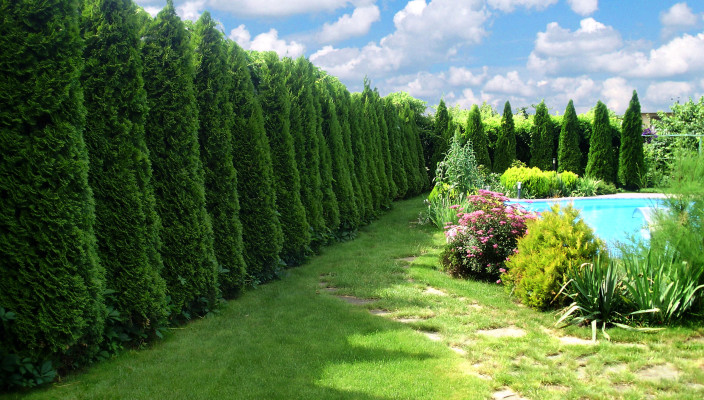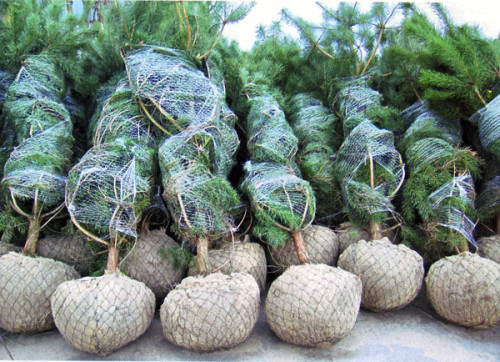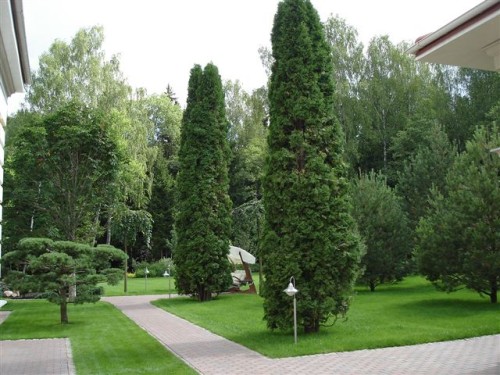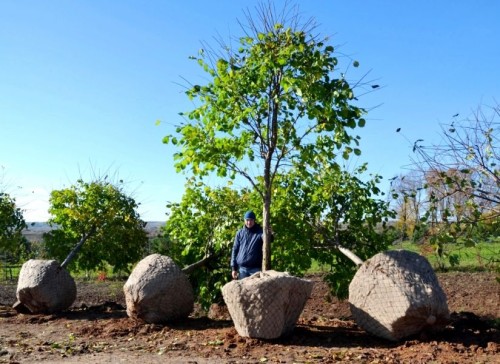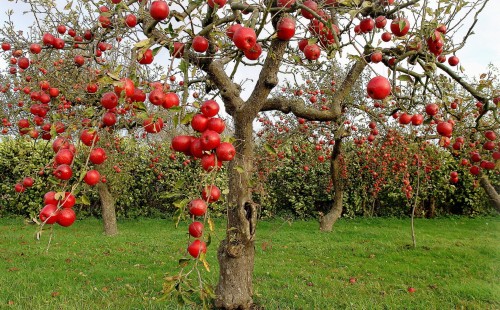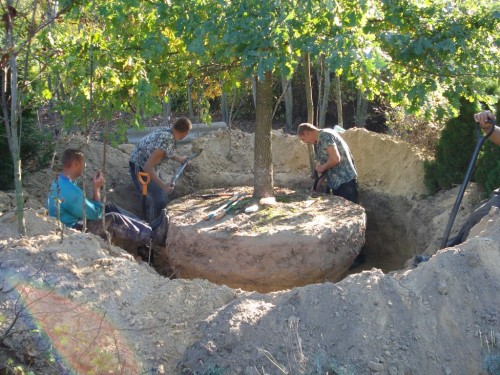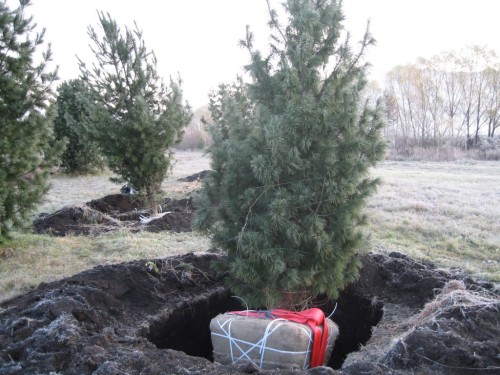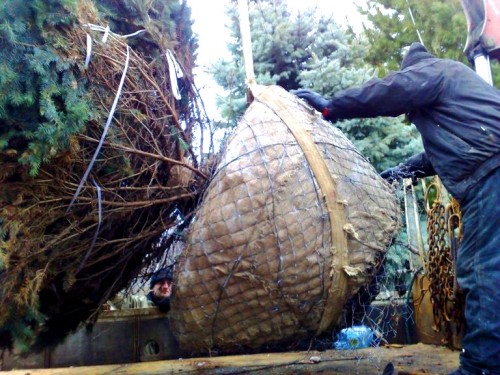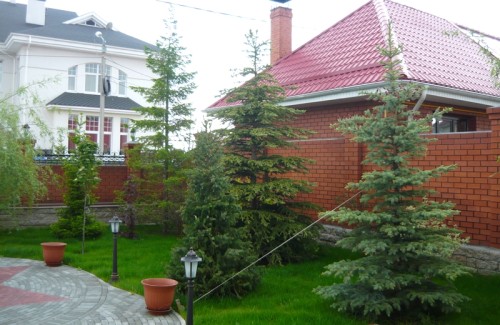With the design of the household plot, many gardeners wish to see adult trees on their territory, but the process of their cultivation from seedlings will take several years. But the landing of trees of largests will help get adult cultures literally immediately. We will tell about the types of major leaders and the peculiarities of their cultivation in this article.
Content
What is large-scale
Maintenancers are large trees or shrubs reaching in a height of at least 1.5 m, although this indicator may be somewhat smaller, depending on the plant variety. Such cultures are customary to dig out from their place of growth and transplant along with the bulk room of the Earth, in which the root system of plants is located. Bigglers are adult trees with fully formed roots, trunk and crown. An earthen com, along with which the large-meter is digging, has a round or trapezoidal form, its weight is an average of 500-600 kg. Planting such plants is a responsible and labor-intensive process carried out in the presence of special equipment, as well as taking into account some knowledge and requirements.
Types and varieties of large-scale
Coniferous cultures
Coniferous trees are very popular in landscape design, as they are evergreen plants and are able to maintain decorative properties even during winter cold. In addition, conifers are frost-resistant cultures, which favorably affects their ability to transplant. However, coniferous trees require great caution during transportation, they are also pretty seriously leaving in a new place and require careful care.
Such cultures include large coniferous plants:
- Spruce - a plant with wonderful decorative qualities, thanks to which it is widely used as an element of landscape design. The positive properties of ate can be attributed to its frost resistance and the ability to grow well and develop on shaded areas. This culture is used to exist in a fairly wet environment, which also needs to be considered when planting a plant. The most beautiful varieties of ate are such varieties: ordinary, Serbian, Canadian, barbed.
- Thuja is a coniferous plant with a magnificent crown and an attractive rich-green color. Thuja is capable of reaching in a height from 10 to 30 m, but there are also more shorter varieties. The plant is noncain, perfectly feels in any soil. Very often used to create an elevation, because the culture is remarkably amenable to haircut, but also single plants on the plot look attractive and noble. Popular varieties can be attributed: Tyu Western and Tyu Colon Featory.
- The coniferous largests applied in the design of gardens and plots is pine. Its distinctive feature is equally and slim trunk. The lower part of the trunk is almost naked, while Krone tree is located quite high. Pines grow well in the soils of any composition, perfectly feel on the territories illuminated by the sun and carry a long drought without any problems. Sutting down pines one by one, through time you can get beautiful, strong and powerful trees with a wide massive crown. Favorite sorts of gardeners are considered: mountain, ordinary, black, Weimutova pine, as well as cedar.
- Fir from other conifers is distinguished by almost smooth bark, as well as symmetrical krone conical shape. To the composition of the soil such a plant is more demanding than his fellow. Fir grows well in fertile lands and loves moderate watering. It is remarkably coming on the shaded, as well as windy sites of the garden. The needle of the plant is soft, has a magnificent fresh fragrance. The fir looks harmoniously both in compositions with other cultures and as a single tree. Popular in gardening varieties are considered: monochromatic, balsamic, Siberian, solidistic fir, as well as Nordman Fir.
- Larch also applies to coniferous cultures, but is not an evergreen tree. Its decorative is due to a beautiful cheese, whose shade is changing from bright green to golden yellow. Larch can land in almost any soil, but the territory is better to choose a well-lit. Landscape designers in the design of gardens apply European and Siberian larch varieties.
- Pseudootsuga refers to the family of pine and is a sufficiently large tree with a spreaded crown. The branches of it, directed up, form the similarity of a wide cone. The needles are painted in green or bluish shades. Pseudootsuga perfectly tolerate frosts, loves drained soil, and also grows well even in adverse environmental conditions.
Large large-scale
Deciduous cultures are beautiful in that in the spring and summer they please the eyes of the emerald greens, and with the onset of autumn they paint into various shades of yellow, orange and even red. Spacious crowns of such trees form a cozy shadow on the plot, creating a feeling of harmony and unity with nature. Popular deciduous leafers include such plants:
- Birch is a favorite of gardeners for its unsurpassed decorative look. This is a thin beautiful tree is not too capricious, it takes good on different types of soils, but too heavy and dense soil for her still will not work. Another one of her plus can be considered the ability to endure frosts without any problems. Plant Berezu better on a well-lit plot. The most popular among landscape designers are such varieties: Karelian birch and hung birch.
- Elm is a major deciduous tree, the trunk of which grows to a height of 25-30 m. Krone has the form of an ellipse, the branches of the plant are thin, decorated with dark green foliage, which is purchased by the autumn yellow-brown tint. Elm perfectly tolerate frosts, can grow on shaded areas and almost in any soil. Some decorative culture varieties are distinguished by beautiful leaves of silver and red shades. It looks best in single landings.
- Grab has a smooth gray bark, as well as a beautiful conical or a spherical crown. An adult tree grows to a height of 10 m, and it can be up to 7 m in gripping. Grab feels well in the fertile soils of neutral or alkaline composition, perfectly transfers cropping. It grows both at sunny sites and in a small shade.
- Oak right is considered to be a tree long-liver. This is one of the most unpretentious crops that absolutely does not need care. Oak resistant to strong frost and long drought. The plant has several decorative varieties used in landscape design. A very popular species is a pyramid oak, which has a magnificent coloniforous crown, slowly grows and prefers a warm climate. In addition to this variety, in gardening also uses such types: oak stuffed and oak red oak.
- Willow is a moisthed culture, often planted on the shores of the reservoirs. Willow is growing well in wet soils and in shaded territories, it perfectly tolerate winter frosts. This plant can also be used for practical purposes, for example, to drain the soil on the too humble household sections.
- Chestnut has wonderful decorative properties thanks to beautiful foliage, as well as inflorescences that appear in the late spring. This plant is best planted on the shaded areas of the garden and follow the good soil moisturgen.
- Another popular deciduous largezer is Maple. From spring to summer, he pleases the eye with its carved openwork foliage of gentle green. With the advent of the autumn, the tree is painted in gold, red, orange or even pink shades. Maple loves moisture and fertile soil, can grow in the shade, but prefers well-lit places.
- Lipa is distinguished by a beautiful, dense crown of oval shape, her foliage is light green, during the flowering period the tree exudes a gentle honey fragrance. In horticulture, two decorative types of culture are most common: Lipa largest and linden mellite. During flowering, which lasts about 1.5-2 weeks, the plant acts as an excellent honey. From the colors of the linden can also be brewed tea. Culture is well tolerating the shadens and winter frosts, but the soil prefers rather fertile and well-moistened.
- In the Gardens of Russia, it is often possible to meet Ryabin. Her petty openwork foliage with the onset of autumn acquires a bright yellow-red shade, at the same time ripen the borders of a saturated-orange berry. Rowan tree is not very large, the trunk is thin enough, crown compact, round shape. Plant berries are not very tasty, but in a frostable form, it is quite edible, besides, the fruits of the plant have drug properties.
- The ash grows up to 10 m in height, has an empty lush crown. Loves sunny territory or light half. With respect to the soil is absolutely noncains, but prefers with fertile soils and good humidity. Thanks to the sprawl branches, it is often used to create natural arbors. Among the gardeners are common in such forms: the ash is fluffy and an ash-ash.
Fruit largest
It is possible to rank fruit trees to the plants. Growing such cultures from small seedlings, it is necessary to wait not one year until the plants give a crop. Therefore, it is more appropriate to disembark already grown trees who will delight fruits after 1-2 years after landing. Among the most popular large-breeders in our country can be allocated with apple trees, cherry, cherry, pear, plum, apricot and mulberry. Recently, with the development of various directions of landscape design, Sakura uses in great demand. It will perfectly complement the garden performed in Japanese style.
Methods of landing largests
By way of landing, large rooms are divided into 3 main types:
- Plants with a surzel room of the earth. Such cultures are often planted on the territory of Russia, the survival rate in trees with a surzel room is quite high. Separate plants are best in nurseries specializing in growing harmonyers.
- Plants with open or closed roots are somewhat worse than in the previous case. Trees require careful care, especially in the first year after landing them to a new place. This departure is a timely abundant watering, feeding, crown processing.
- There are also cultures grown in containers. Such largets of largest largets can be purchased in Poland or Germany - countries specializing in the production of such products. Surveillance of trees in this case will be almost 100%, moreover, it is possible to plant them on a new place at any time of the year. The only disadvantage of such products may be its high cost.
Features of landing largests
Digging the planting material
So as not to injure the branches and roots of the plant, the tree must be digging with special accuracy. The lower branches are first tied to the trunk, after which they produce the root system from the soil along with a large room of the earth. Performing a similar job, it is desirable not to damage the roots. In addition, patients and dry branches should not be removed at this stage, because during the transport of plants, they can serve as a kind of buffer and protect healthy branches from breakdown. All damaged fragments of the tree are removed after the plant is discharged into the pit.
The diameter of the round earth coma must be calculated in advance. Its size should be 10-12 times greater than the diameter of the tree stan. The size of the cubic shape can be from 1 to 2.5 m in length and width, as well as 0.7-1 m in height. If the tree is not very large, you can dig it manually, trying to capture as much land as possible.
The depth of digging depends on the specific culture, as well as the conditions in which it grown. For example, for a spruce growing in crude soil, the diameter of the coma must be at least 1.5 m, and the height is about 0.5 m. If the fir grew in light loam, the depth of digging will be more - approximately 1-1.2 m. Remove the roots of the plant from the ground together with a comment using a hydraulic jack, the load capacity of which is 15-20 tons.
Plant Packaging and Transportation
Before transporting a tree to a new place, an earthen one needs to be packaged in a special container basket made of metal. This container has a detachable design. After the plant is delivered to the address and load in a pre-prepared pit, the walls of the basket are released and pulled out on the surface, while the root system with a coma remains in the ground. As for large crops with large roots, their kids are wrapped with a burlap or metal grid. If the com discourages from the frozen soil, it can be transported simply so, without turning.
After you borrowed a bigger, take care of its correct transportation to a new place. For this work, you will have to use some special technique, such as a truck crane, a car-all-terrain vehicle with a hydrauliculator, a truck, mini loader, trees transplant, etc. To capture the tree and consolidate it on the vehicle, resort to the help of steel or textile sling, screeds, carbines. It is very important during the fixation of the plant in the car body does not damage the bark. After the largest is laid in the body, the trunk is propheted with wooden strips, so that the crown branches have not broken during the transportation.
The subtleties of landing largests
- Transport trees is best in winter, not forgetting to learn the weather forecast in advance. Dropping and transporting large-scale at temperatures below -18 ° C is extremely not recommended, because with a strong frost, wood becomes fragile and easily breaks.
- It is necessary to plant large-leaved in a new place with an earthen room with which they were dug earlier.
- Treed transplantation is better to do when the plants come at rest. In our latitudes, this period lasts from October to March. Digging out the earthen com and transport it is easiest in winter, in addition, being in a state of rest, the transplanted tree is easier to fit in a new place.
- If you transplant coniferous plants, do not forget to observe the spatial orientation of the branches. This means that turning the tree to the north is needed that sider, how it was turned into the same side at the same place of growth.
- The landing of large-scaler is carried out using special equipment or manually, depending on the size of the plant and the features of the site layout. The easiest way to transplant trees with a crane, but the manual way will be less traumatic for plants.
- The size of the pit for planting should correspond to the dugout to whom, in addition, the pit from the bottom should have a small supply.
- When landing, the top of the earthen coma should not be lower than the level of the soil, so that the horse neck is not blocked. If this happens, the large-meter can die after a while.
- The composition of the soil is chosen depending on the specific culture. After planting a tree, about the middle of its trunk, you need to fix reliable stretching. If the largezer is planted in winter, to protect the roots from severe frosts, you can pour around the barrel of the snow layer.
CARE FOR MARKERS After Landing
When the plant comes in the plant, it is necessary to treat them with special means against diseases and pests. You can also add solutions of growth stimulants into the soil. Due to the fact that after the transplantation of the trees is a bit damaged roots, foliage will be quite small. At this time, it is recommended when watering the stimulants of the root formation to the water. In the first year after transplanting, the irrigation of cultures should be carried out daily, moistening not only the soil, but also the branches of the plants.

